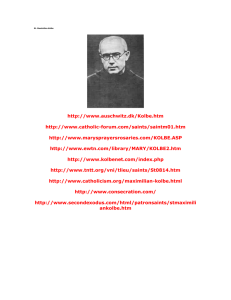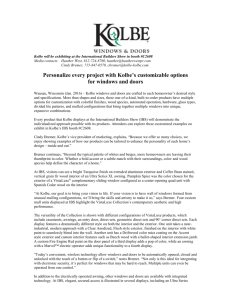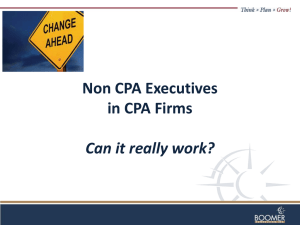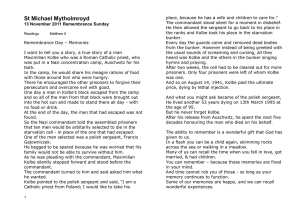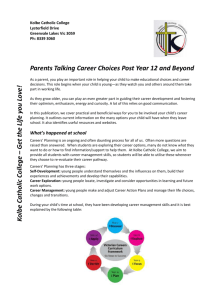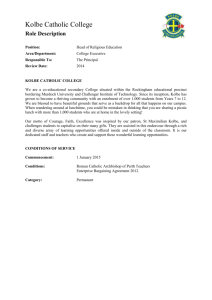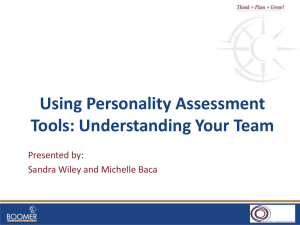Kathy Kolbe
advertisement
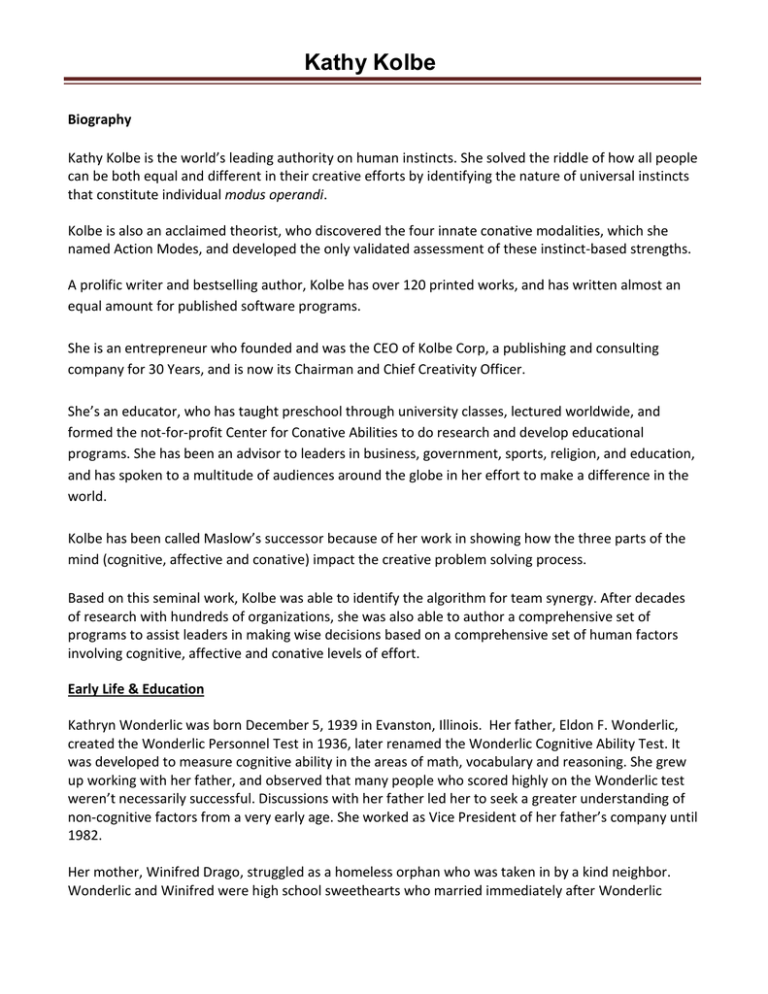
Kathy Kolbe Biography Kathy Kolbe is the world’s leading authority on human instincts. She solved the riddle of how all people can be both equal and different in their creative efforts by identifying the nature of universal instincts that constitute individual modus operandi. Kolbe is also an acclaimed theorist, who discovered the four innate conative modalities, which she named Action Modes, and developed the only validated assessment of these instinct-based strengths. A prolific writer and bestselling author, Kolbe has over 120 printed works, and has written almost an equal amount for published software programs. She is an entrepreneur who founded and was the CEO of Kolbe Corp, a publishing and consulting company for 30 Years, and is now its Chairman and Chief Creativity Officer. She’s an educator, who has taught preschool through university classes, lectured worldwide, and formed the not-for-profit Center for Conative Abilities to do research and develop educational programs. She has been an advisor to leaders in business, government, sports, religion, and education, and has spoken to a multitude of audiences around the globe in her effort to make a difference in the world. Kolbe has been called Maslow’s successor because of her work in showing how the three parts of the mind (cognitive, affective and conative) impact the creative problem solving process. Based on this seminal work, Kolbe was able to identify the algorithm for team synergy. After decades of research with hundreds of organizations, she was also able to author a comprehensive set of programs to assist leaders in making wise decisions based on a comprehensive set of human factors involving cognitive, affective and conative levels of effort. Early Life & Education Kathryn Wonderlic was born December 5, 1939 in Evanston, Illinois. Her father, Eldon F. Wonderlic, created the Wonderlic Personnel Test in 1936, later renamed the Wonderlic Cognitive Ability Test. It was developed to measure cognitive ability in the areas of math, vocabulary and reasoning. She grew up working with her father, and observed that many people who scored highly on the Wonderlic test weren’t necessarily successful. Discussions with her father led her to seek a greater understanding of non-cognitive factors from a very early age. She worked as Vice President of her father’s company until 1982. Her mother, Winifred Drago, struggled as a homeless orphan who was taken in by a kind neighbor. Wonderlic and Winifred were high school sweethearts who married immediately after Wonderlic finished college at Northwestern University in three years. She became a Registered Nurse. They had four children of which Kathy was the youngest. Kathy Wonderlic (aka Kay, in high school and college) was a gifted student with severe learning disabilities (now labeled dyslexia, dysgraphia, and ADD). It took months of tutoring before she could even write her name, and she was in the third grade before she could read. Kathy became known as a crusader from an early age. Her passion for social justice began taking shape during this time when she was nearly kicked out of her Girl Scouts Brownies club for speaking out against racial and religious segregation. Her interest in fighting for accommodation for the disabled began taking shape in the fourth grade, as she helped her disabled friend with classroom activities and missed a field trip to stay behind with him because the activity wasn’t accessible to him. This led to accommodations for him in the future. At Skokie Junior High School, Kay’s leadership skills blossomed. She was editor of the school newspaper and gave the graduation speech. She attended New Trier High School, and disabilities notwithstanding, she wrote and co-directed a musical, Lagniappe, and was feature editor of the school paper. While in high school, she attended numerous business meetings and functions with her father and he trained her to understand and evaluate businessmen. As a junior, she was selected to participate in a national study of economics in education, and assigned to study and describe the GNP (Gross National Product) to the panel. Her success bolstered her confidence in the business world and later encouraged her as a business woman in a man’s world. She graduated in 1957. Kay Wonderlic enrolled in Northwestern University where she majored in journalism, was very active in campus politics, and was on the Dean’s list. She was a member of Gamma Phi Beta, several honorary sororities/fraternities, Mortar Board and the Editorial Board of Student Publications. Kathy also served as Vice President of the Student Body, Chairperson of the Student Judiciary, Dorm President (600 women), and was elected May Queen. She graduated with high honors in 1961 with a Bachelor of Arts in Journalism and a duel major in sociology, she was also honored by the Chicago Tribune as one of the Outstanding Young Women on American Campuses. In 1962, Kay Wonderlic was “de-pinned” from Gamma Phi Beta because during a speech at its national convention she advocated religious diversity and minority membership in the Sorority. That was also the year she was first paid as a public speaker. As the VP of Northwestern’s Student Governing Board, Kay Wonderlic represented the university at the 1960 convention for the National Students Association (NSA). She discovered that the few thousand students there were being influenced by highly financed political activists. She determined that there were issues of international political importance about which most of student representatives were fairly ignorant, but the political activists wanted them to issue statements regarding them. Wonderlic created an ad hoc organization she called the Students Committed to Accurate National Representation (SCANR) – and with press releases and soap box speeches, she drew attention to the potential for misrepresentation. Wonderlic’s efforts led to her being featured in the New York Times, the lead Sunday editorial in the Chicago Tribune (“Queen with a Cause” – referring to her recent role as NU May Queen, and in ending the era of student apathy), and to being a speaker at a jam-packed Madison Square Garden event. What she enjoyed most was debating against the leader of the left-wing influencers – Tom Hayden (future member of the Chicago Seven, and US Senator) – on numerous campuses across the US. She also debated against the head of the right-wing effort, who also became a noted political activist on that side of the spectrum. Wonderlic negotiated with Northwestern faculty members, who gave her the equivalent of almost a full semester of academic credits for the research, documentation and presentation of the NSA battle, which she published in a pamphlet and distributed to over 8,000 student leaders and the media. A book publish after 2000, detailing student activism in the 1960’s refers to Kathy Wonderlic as an initiator of the movement. When the US government released CIA documents on its investigations from that era, apparently only Tom Hayden had more files than she did – but they were never able to figure out who she “was working for” - because she was truly self-motivated and didn’t represent any political group. Wonderlic also initiated the first student evaluation of university professors that had been done on an American campus. Her fights with “injustice” became legend there. Development Years In 1962, Wonderlic married John David Kolbe, whom she met at Northwestern University while they were both journalism students. He became an officer the US Navy and they immediately moved to Newport, R.I., where she, as Kathy Kolbe, worked for the Newport Daily News. On December 7, 1964, after he became a civilian newspaper writer and they lived in Rockford, Il, her daughter Karen was born. She gave birth to her son, David John Kolbe, on January 7, 1967. During that time she worked by distance with her father on test development. In 1969, they moved to Springfield, Illinois where he became Press Aide to Illinois Governor, Richard Ogilvie. Kathy Kolbe created her own job by forming the Governor’s Citizens’ Involvement Council, of which she was chairman. She became heavily involved in his efforts on behalf of the retarded, spearheaded by his wife, Dorothy, with whom Kathy travelled. During this period Kathy observed a great deal about what and how retarded youngsters could learn. In 1973, after the governor was not reelected, the young Kolbe family moved to Phoenix, Arizona where John worked as a political columnist for the Phoenix Gazette. Kathy Kolbe became busy with caring for their garden and yard and was soon being enlisted to help others. This led the budding entrepreneurial business, Wonder Gardens, and to her obtaining an Arizona Nurseryman’s license. Three months after arriving in Arizona, at a meeting of concerned parents and teachers, she was named Chairman of a committee to design and implement a gifted program for the Scottsdale School District. She led the development of a unique program based on teaching creative problem solving which led to her becoming an advisor to the Arizona Department of Education, co-creating the AZ Association of Gifted and Talented, and to designing the first course for and becoming the first Adjunct Professor of Gifted Education at Arizona State University. In 1974, in order to help all kids learn creative problem solving methods, Kolbe originated a Special Program for Individual Explorations (SPIES) with over 250 students participating per year for four years. During this period of developing programs for kids, raising her own kids, and building her entrepreneurial publishing company, Resources for the Gifted, Kolbe had plenty of opportunities for doing her own problems solving. She found human behaviors fit into patterns of acting, reacting and interacting. By the last year of SPIES, she had written the first assessment of many variations that later became the Kolbe A ™ Index, the first measurement of the purposeful acts resulting from innate problem solving methods. Educators who came to observe SPIES classes had created the demand for the materials and activities Kolbe used. To meet this need, she began running a teacher-supply warehouse in her spare bedroom, and was soon mimeographing activity books she either wrote or edited. Educators from around the country started coming to seminars she conducted to learn how to integrate her unique “enrichment” materials into regular classrooms. Kolbe also provided programs for parents, many of whom were business leaders who sought out her help with their “high potential employees.” She saw all employees as high potential, through differing M.O.s (modes of operation), proving this required that she develop an adult version of the assessment she had been working on for kids. It was the beginning of what is now known as the Kolbe Y™ Index, and the Kolbe A™ Index. Resources for the Gifted Kolbe started what would become an award-winning publishing company, Resources for the Gifted, to provide materials to educators working with gifted youngsters. It was the first in the US to publish and distribute materials specifically designed to meet the needs of such children. It began primarily as a mail-order business with one part-time employee and a hand-mimeographed catalog, but grew quickly as word spread, and Kolbe developed her theories regarding conation and human behavior. Soon she was conducting seminars, workshops, research, and was a leader in the field of direct-mail sales. She started a non-profit arm for research and grant-work in 1977, originally named The Center for Critical and Creative Thinking (aka Think Inc.), now named The Center for Conative Abilities. Soon the company outgrew Kolbe’s home and she bought her own building, which she would expand and stay in for 32 years. Within four years she had 27 full-time employees, and 12 contributing authors and artists. She published over 100 children's problem-solving workbooks (Think-ercises® activities), which were purchased by more than 30,000 schools in 15 countries, and set a worldwide standard for K-12 gifted education. In 1979 Kolbe’s father passed, and she divorced her husband. She continued all of her efforts for the next seven years as a single parent. By 1981, Kolbe she had completed her alpha research on both the Youth and Adults version of her assessment, which she gave various names, The Wonderlic-Kolbe Index and the Impact Factors Test, among them. The latter,(which she called the “If – for If I ever figure out what I’m measuring”). While beta tests of hundreds of subjects from a wide variety of places showed the tests were valid in identifying some type of trait, it was clear to Kolbe that it differed from cognitive abilities, and affective personalities – but she did not know of a third part of the mind that it could be measuring. She sought out experts to help, and could find none with answers. In the early 1980s Kolbe ran her thriving publishing company, which now was providing highly innovative books, games that teach problem solving for all kids – and therefore had the new name of Kathy Kolbe Concepts. She had begun an extensive training program for teachers around the country. She also served on civic boards, and was leader in the community, including in the Chamber of Commerce. She added research regarding her assessments to everything else she did. She was discovering the modes of action among civic leaders, business people, vendors, teachers, students in every class she taught or gave a lecture, church members, actors, athletes, her advisors’ legal and accounting firm professionals, and even her landscapers. In 1984 she won numerous awards, including the AZ Business Person of the Year award, and in 1985 she honored at the White House as one of the country’s leaders in over-coming obstacles. At the end of 1985 Kolbe was featured in the Time magazine Person of the Year article as one of seven people who exemplified the can-do spirit in America. Starting Over In 1986, Kolbe’s youngest child was heading to the University of Pennsylvania for college, and for the first time, she was willing to travel extensively. Immediately after becoming the University of Arizona’s first woman Entrepreneurial Fellow, she was set to begin a nationwide speaking tour, a preamble to the 26-city book tour she would launch as soon as the book she was writing a book for Random House was published. While writing her book The Conative Connection, she was in a serious car accident which resulted in a traumatic brain injury. Temporarily losing the ability to read and write forced reliance on her instincts to recover, which led to her greater understanding of conative brain function in a way no other type of research could ever have made possible. She reinvented her business on the foundation of the Kolbe A™ Index, an assessment she developed to measure the conative part of the mind. It was during this time of recovery she became acquainted with international businessman, William K. Rapp. Kolbe retained her name when they were married on June 20th, 1987. Rapp had three children of his own; their blended family has five children and nine grandchildren. The business shrunk to only three employees while she recovered from the car accident in 1986. As she depended on her conative strengths to overcome brain damage, Kolbe realized that everyone was gifted and needed the opportunity to benefit from her research and knowledge, not just children. She finished the book, The Conative Connection and published the Kolbe A Index in 1989. She also reinvented the company, initially naming it Kathy Kolbe Corp, later shortening it to Kolbe Corp, and began serving business, education and government clients of all sizes. Kolbe’s achievements in advancing the understanding of human nature have led to studies of her work at Stanford, Harvard, University of Chicago, UCLA, California State University, and other universities throughout the world. She is an Entrepreneurial Fellow at the University of Arizona, and has been an adjunct professor at Arizona State University. She spends considerable time working directly with youngsters through her non-profit, The Center for Conative Abilities. The Kolbe A™ Index Unsatisfied with IQ-based identification of abilities, Kolbe spent years studying the mysterious conative patterns of behavior, which have largely been ignored by academics during the last century. She authored the first reliable measurement of conation, the Kolbe A™ Index, which identifies the patterns of actions or modus operandi of an individual and developed coaching-type results which are individualized, internet-delivered, insights in applying the information in real-life situations. This revolutionary assessment provided an entirely new approach to mental measurement and the explanations of it. Kolbe Corp As the company grew, it evolved into a family business involving Kolbe’s son David Kolbe, her husband Will Rapp, and his daughter Amy Bruske as principals. Kolbe has advised Fortune 500 companies, business executives, government leaders, Chief Justices, universities, professional sports teams, nonprofits, management consultants, bestselling authors, surgeons, monastery priests, four-star generals, and job holders to maximize performance and increase productivity through identifying, understanding, and using conative talents. She also provides advanced training to Kolbe Certified™ Consultants who consult with individuals, managers, business leaders and corporations throughout the world. Kolbe has delivered presentations to audiences in 17 countries (including keynoting for Management Center Europe, the Global Leadership Conference, and the State of the World Conference) and has discussed her groundbreaking work on over 300 radio and TV programs. Kolbe has received much recognition and many awards for her work in education and business accomplishments – including being the first woman in the Phoenix 40 (Top 40 Phoenix Executives). The Center for Conative Abilities Kolbe founded the Center in 1977. Its original work was to clarify the creative process, and provide programs that fostered its use in individuals of all ages. Dr. Willard Abraham, then Dean of the Arizona State University School of Education, worked with founder Kathy Kolbe in delving deeply into the mind of the gifted child. Others from universities, government, and industry joined in the effort, providing funds and case studies. Within two years of its inception, The Center was conducting programs for youngsters throughout Maricopa County, AZ, that furthered their use of critical and creative thinking. By then, the Center had determined that all children, not just the intellectually gifted, were capable of achievement at the highest levels of creative problem solving. Its seminal program for all kids, known as SPIES (Summer Program for Individualized Explorations), served over 2000 youngsters over five years. Throughout that era, parents and educators participated in programs that demonstrated how they could teach critical thinking and nurture the creative process. It became clear that these two processes were separate, with critical thinking being a part of the creative process – and there being a third element, which was innate. By its second decade, the mid 1980’s, The Center had provided programs and materials for educators and parents from 31 states and several foreign countries. Those diverse contacts and the numerous qualitative studies that grew from activities involving them, provided convincing evidence that the historically recognized third domain of the mind, conation, was the mysterious innate element in the creative process. Conation was proving to be as equally important to the creative process as the cognitive and affective domains. In 1987, The Center officially changed its name to the Center for Conative Research. Studies were conducted worldwide. Participants included such diverse populations as the International Association of Zoos and Aquariums, the Chamber of Commerce at The Hague, Netherlands, the Arizona Supreme Court, handicapped kids in the United Kingdom, National Basketball Association athletes, police officers in Canada, airline pilots in Korea, the CIA, and teachers from the United Arab Emirates. The Center provided materials and services for matching and other grants for research related to families, early childhood development, learning, health, self-management, and leadership. • • • Data collected during The Center’s research showed that, while conation was now being recognized as a key element to organizational success in the private sector, conative abilities were proven not only to be ignored, they were also found to be misidentified as the cause of negative effects among school children. Labeling many youngsters’ positive conative traits as ADD/ADHD behaviors and trying to “control” them through behavioral modification, even drugs, soon extended to doing the same with adults with those conative traits. Instead of recognizing conative abilities as innate advantages, quantitative and qualitative studies sponsored by The Center discovered they were being thwarted. The Center decided to provide programs for parents and educators to both inform them of children’s diverse conative abilities and of the impact of neglecting or misidentifying them. The Perfectly Capable Kids program was launched through a grant from the Dean of Arizona State University’s College of Public Programs. The program was very successful but exposed the widespread ignorance of the influence of conation in the learning process. • In 2006, The Center updated its name to the Center for Conative Abilities with a focus on training selected community leaders to become conative coaches, to providing constructive self-management programs for kids whose conative abilities have been misidentified as disabilities, to providing parental support and to providing community awareness of conation’s essential role in reducing stress, improving health and achieving goals. Career History o Aide to Governor of Illinois o Vice President of Wonderlic, Inc. o Adjunct graduate professor at Arizona State University o Education and Advisor/Consultant: • California State University, Northridge • Kansas State Department of Education, Topeka, KS • Pima Elementary School, Scottsdale, AZ • Theroux Demonstration Academy, Tulsa, OK • University of Chicago o Founded Resources for the Gifted o Founded Kolbe Corp o Founded the Center for Conative Abilities Community Involvement o Served as Chairman, Illinois Governor’s Citizens Involvement Council o Co-founder and Chairman of Arizona Association for Gifted and Talented Children o Chairman of Scottsdale, Arizona Committee for gifted Children o Director of Phoenix Children’s Theater o Director of Upward Foundation for the Retarded o Founder and Chairman of the National Council for Critical and Creative Thinking Skills o Served as a member of the Executive Board of Arizona Center for Law-Related Education o Served on the Ethics Review Board of Directors for the Arizona Bar Association o Served on numerous legislative review and local government boards and commissions o Served on Phoenix Local Development Corporation o Served on the Boards of Directors of the Small Business Councils of the Arizona and Phoenix Chambers of Commerce o Served on the Board of Directors for the Arizona Association for Handicapped Kids Awards & Recognition 1982 - Arizona Small Business Association’s Business Person of the Year 1982 - Featured in U.S. News & World Report “Special Issue on Business,” on her decision-making practices 1982 - Highlighted in Money magazine article as “Doing Well by Doing Good,” 1983 - Recognized by Family Circle Magazine as one of four outstanding women entrepreneurs 1982 - Featured in Direct Marketing magazine as an example of phenomenal business success 1984 – Honored by the White House as "one of America's Can-Do People” 1985 – Recognized in Time magazine’s 1985 “Man of the Year” issue, in which she was cited as one of seven Americans who possess the “spirit to inspire.” 1985 – Received Bullock’s Portfolio Award for outstanding women leaders 1992 – International Women’s Forum ‘Woman of Achievement’ Award 1997 – Inducted into the Northwestern University's Medill School of Journalism Hall of Fame 2011 – Robert E. Fox Lifetime Achievement Award – honoring 30 Years of Brain Research That Maximizes Mental Energy -- Boosting Business Productivity and Reducing Personal Stress Published works Kolbe, K. Kolbe A™ Index. Phoenix, AZ: Kolbe Corp. Kolbe, K. Kolbe B™ Index. Phoenix, AZ: Kolbe Corp. Kolbe, K. Kolbe C™ Index. Phoenix, AZ: Kolbe Corp. Kolbe, K. Kolbe IF ™Index. Phoenix, AZ: Kolbe Corp. Kolbe, K. Kolbe R™ Index. Phoenix, AZ: Kolbe Corp. Kolbe, K. Kolbe S™ Index. Phoenix, AZ: Kolbe Corp. Kolbe, K. Kolbe Y™ Index. Phoenix, AZ: Kolbe Corp. Kolbe, K., (2010) Protocol for the neuroscientific investigation of the conative faculty of the mind. Phoenix, AZ: Center for Conative Abilities. Kolbe, K. (2008). Conation: A successful model for succession. Retrieved from http://www.kolbe.com/pdfassets/kolbesuccesionmodel.pdf Kolbe, K. (2008). Conation: wisdom of the ages. Google Knol™, Retrieved from http://knol.google.com/k/conation#. Kolbe, K., Young, A.M., & Gerdes, K.A. (2008, March). Striving instincts and conative abilities: The testretest reliability of the Kolbe A™ Index. Paper presented at the Annual Meetings of the Western Academy of Management, Oakland, CA. Hallowell, E.D., & Jensen, P. (2008). Superparenting for ADD: an innovative approach to raising your distracted child. (K. Kolbe, Contrib.). NY: Ballantine Books. Kolbe, K. (2007). How to get more done. Retrieved from http://www.kolbe.com/pdfassets/how-to-getmore-done.pdf. Kolbe, K. (2004). Impulsive? Distracted? Quick start? Experts say you suffer from ADD. Retrieved from http://www.kolbe.com/pdfassets/experts-say-you-suffer-from-add.pdf. Kolbe, K. (2004). Powered by instinct. Phoenix, AZ: Monumentus Press. Kolbe Corp. (2002). Kolbe statistical handbook: Statistical analysis of Kolbe indexes. Phoenix, AZ: Author. Kolbe, D. & Kolbe, K. (1999). Management by instinct leads the way to change. Retrieved from http://www.kolbe.com/pdfassets/management-by-instinct.pdf. Hoffman, E. & Kolbe, K. (1999). Parenting by instinct. Retrieved from http://www.kolbe.com/pdfassets/parentingarticle.pdf. Hoffman, E. (1999). Relationships built on instinct. (K. Kolbe, Contrib.). Retrieved from http://www.kolbe.com/pdfassets/relationships-built-on-instincts.pdf. Kolbe, K. (1994, October). Avoiding a mentor mismatch. Working Woman, 66-69. Kolbe, K. (1993). Pure instinct. NY: Random House / Times Books. Kolbe, K. (1990). Conative connection. Reading, MA: Addison-Wesley Publishing Company. Kolbe, K. (1989). Wisdom of the ages: Historical & theoretical basis of the Kolbe concept. Phoenix, AZ: Kolbe Concepts, Inc. Kolbe, K. (1984). Challenges through Narnia v. II. Phoenix, AZ: Resources for the Gifted. Kolbe, K. (1983). Bonkers bingo. Phoenix, AZ: Resources for the Gifted. Kolbe, K. (1983). Computer think. Phoenix, AZ: Resources for the Gifted. Kolbe, K. (1983). Create me clowns. Phoenix, AZ: Resources for the Gifted. Kolbe, K. (1983). Galaxy of perplexities. Phoenix, AZ: Resources for the Gifted. Kolbe, K. (1983). Getting kids ready to take on the world. Phoenix, AZ: Resources for the Gifted. Kolbe, K. (1983). Imagine that! Phoenix, AZ: Resources for the Gifted. Kolbe, K. (1983). Lessons in logic. Phoenix, AZ: Resources for the Gifted. Byron, G., Ellis, M., Ganci, M. and Kolbe, K. (1983). Library lingo. Phoenix, AZ: Resources for the Gifted. Kolbe, K. (1983). Magic of math. Phoenix, AZ: Resources for the Gifted. Kolbe, K. (1983). Mental workouts. Phoenix, AZ: Resources for the Gifted. Kolbe, K., & Wells, R. (1983). What’s missing? Phoenix, AZ: Resources for the Gifted. Kolbe, K., Kolbe, K.W. & Wells, R. (1983). What’s next? Fun thinking activities for 4-8 year olds. Phoenix, AZ: Resources for the Gifted. Kolbe, K. & Wells, R. (1983). Whoppers. Phoenix, AZ: Resources for the Gifted. Kolbe, K. & Wells, R. (1983). Why there? Phoenix, AZ: Resources for the Gifted. Kolbe, K. (1982). Analyze activity center. Phoenix, AZ: Resources for the Gifted. Kolbe, K. (1982). Books and beyond. Phoenix, AZ: Resources for the Gifted. Kolbe, K. (1982). Character building: Concept to curtain. Phoenix, AZ: Resources for the Gifted. Kolbe, K. & Kolbe, K.W. (1982). Comix. Phoenix, AZ: Resources for the Gifted. Kolbe, K. (1982). Cosmic creativity. Phoenix, AZ: Resources for the Gifted. Kolbe, K. (1982). Droid’s dilemma. Phoenix, AZ: Resources for the Gifted. Kolbe, K. (1982). How-to who done it. Phoenix, AZ: Resources for the Gifted. Kolbe, K. (1981). Classic ideas. Phoenix, AZ: Resources for the Gifted. Kolbe, K. (1981). Computer readiness. Phoenix, AZ: Resources for the Gifted. Kolbe, K. (1981). Create-a-code. Phoenix, AZ: Resources for the Gifted. Kolbe, K. (1981). Dynamic designs: lines, points and patterns. Phoenix, AZ: Resources for the Gifted. Kolbe, K. (1981). Discovery unlimited: Thinking through the humanities. Phoenix, AZ: Resources for the Gifted. Kolbe, K. (1981). Enigmas. Phoenix, AZ: Resources for the Gifted. Kolbe, K. (1981). Magnasticks. Phoenix, AZ: Resources for the Gifted. Kolbe, K. (1981). Spelling for the creative classroom. Phoenix, AZ: Resources for the Gifted. Kolbe, K. (1981). The great brain: a learning center. Phoenix, AZ: Resources for the Gifted. Kolbe, K. (1981). To be or knot to be. Phoenix, AZ: Resources for the Gifted. Bitter, W., Forseth, S. and Kolbe, K. (1981). Visual math: Investigate! Calculate! Phoenix, AZ: Resources for the Gifted. Kolbe, K. (1980). Adventures with Cinnamon Bear. Phoenix, AZ: Resources for the Gifted. Kolbe, K. (1980). Mind’s eye. Phoenix, AZ: Resources for the Gifted. Kolbe, K. (1979). This way to thinking. Phoenix, AZ: Resources for the Gifted. Additional Works Authored Materials and Conceptual Works: Career MO+™ Catalyst: Gut Checks for Career Moves Commitment Clarifier® Conables® Tips Conflict CounterActives™ Depletion Indicator™ Dynamynd® Decision Ladder Efficiency Indicators – Individual Efficiency Indicators – Leader FairSelection® System Financial MO+™ Inertia Analysis™ Kolbe Bottom Lines™ Booklet Kolbe Career Queries™ Kolbe Catalyst™ Kolbe Certification™ Manual Kolbe Comparisons™ booklet Kolbe RightFit™ Kolbe Range of Success™ Kolbe Strengths™ Leadership Analytics™ Report Conative Inventory DIIE Scale™ Productivity Factors Meltdown Probability™ Niche for Knack® Polarization Web™ Sales MO+™ Stress Detector – Strain™ Stress Detector – Tension™ Team Synergy™ Report User’s Manual for the Mind Audio (continued): Kolbe Forecast Kolbe RightFit Kolbe Selection Process Kolbe Takes Two Kolbe TeamTactix Leadership Learning Disabilities Natural Advantage™ Series Parenting: Nurturing Your Child’s Instincts Power of Prevention Reliable Responses Strong Suit: Playing to Your Strengths The Strength Inside Every Student Your Instinctive Strengths Think-ercise™ Books and Materials: 101 Brain Teasers Analogies and Similes Analyze Animals! Animals! Audioriginals Book Reports Brain Scratchers Brainstorms Comparisons Creature Curiosities Decide and Design Dizzy Gizzy Do It Yourself Critical and Creative Thinking Evaluate Fathom: Probe the Past - Plan the Future Geography Quizzles Audio: Avoiding Stress Bridging Differences Coaching for Maximum Performance Commitment: Making the Effort Commitments You Can Keep Communicating Naturally Communication: Making it Work Dealing with Transitions Dynamynd FMO+™ Initiating Solutions Kolbe Career Queries Kolbe Concept® Kolbe Creative Process Mind over Math Mission Logic Nothing Doings Number Sense Options and Observations Ouchless Curiosity Political Strategies Power of Proof Problems in Perspective Project Problem Solving Reasonable Rules for Writing Reinforcements Secrets of Signing Sensory Fair Sign Up Simulations Smatterings Go Power Good News Great Brain Kit History Quizzles Humor: Anatomy of the Funny Bone Independent Projects Interact Character Building Investigations and Calculation IQ Exercises Lines, Points and Patterns Locker Room Logic Logisticks Made in America Mazes and Illusions Milky Mystery Solar Power Winners Sound Ideas Special Gifts Sprouts Starting Points Survival Skills Synthesize Tale Ends Techniques of Problem Solving I and II That’s Credible: Concocting Believable Myths The Joy of Learning Thinking Persons’ Guide to Self Help Tip of the Iceberg Tomorrow Wise TV – A Tool to Turn on Thinking Using Your Senses Weird and Wonderful Wordles I and Wordles II
